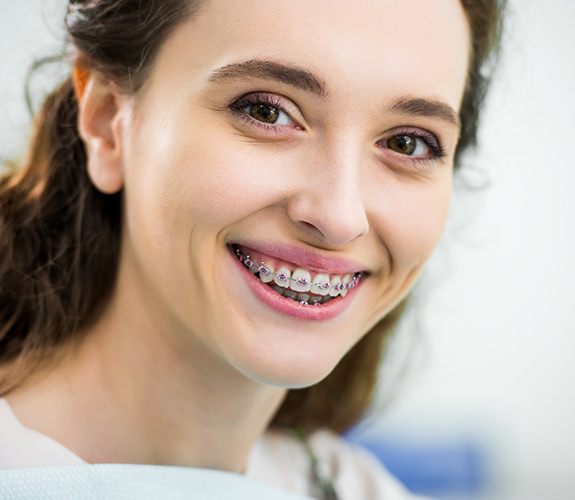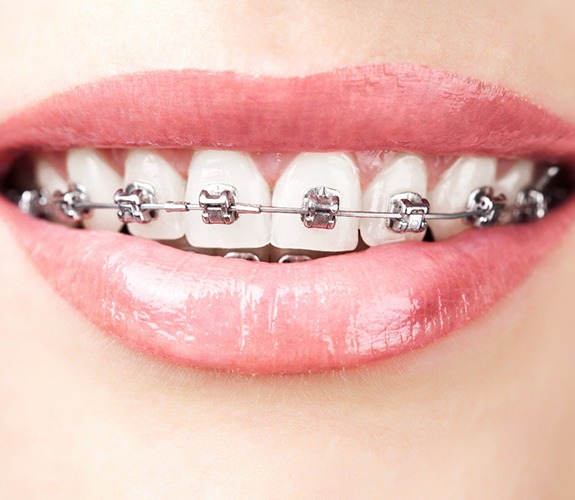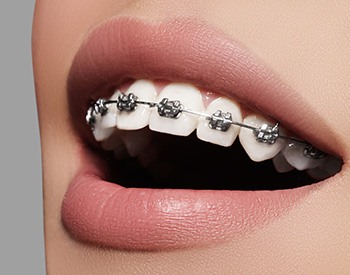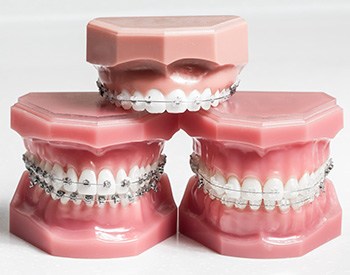
Traditional Braces – Sycamore, IL
Treating Complex Orthodontic Issues
Traditional braces are well-known for being an effective, reliable orthodontic treatment. They are highly recommended for correcting both simple and complex cases of misaligned teeth and jaws. The treatment is normally recommended for children, but adults can benefit from wearing them too, and they are highly recommended for anyone that is having difficulty speaking or eating due to the alignment of their teeth. Our in-house orthodontist at Grand Dental – Sycamore uses metal braces to address many different kinds of orthodontic issues; call today to learn more about how the treatment works.
Why Choose Grand Dental – Sycamore for Braces?
- Knowledgeable In-House Dentist
- Treatments for Adult and Child Patients
- Friendly, Experienced Team
How Do Traditional Braces Work?

Braces consist of a number of metal brackets and wires. The brackets are attached to the teeth, and the wires (held in place by elastics) connect them. The pressure exerted on the teeth by the wire will gradually push them to a new position. To make sure that the braces continue to apply the right amount of force to the teeth, we will schedule an appointment every 4 to 6 weeks to tighten them.
The timeline for wearing braces can look drastically different from patient to patient, but the average is between 18 months and three years. The complexity of the case at hand is a major factor in how long the treatment takes. Our office is fully prepared to handle complicated orthodontic cases, and we will always be transparent about how long we expect the treatment to last.
What Orthodontic Issues Can Braces Fix?

When an orthodontic issue is too severe to be fixed with clear aligners, braces generally remain a viable option. The following are common examples of issues that traditional orthodontics tend to be effective in fixing.
Bite Misalignment
Overbite, underbite, and crossbite can all lead to numerous oral health issues, such as causing the enamel protecting the teeth to wear down unusually fast. Braces can be used to resolve many different bite alignment issues.
Crowded & Crooked Teeth
Crowded teeth can detract from your appearance, and they are difficult to clean properly. They can be straightened and properly spaced with traditional braces.
Gapped Teeth
A gap between teeth near the front of the mouth can be embarrassing. The empty space can often be closed with traditional braces.
Caring for Your Braces

When wearing braces, you will need to adjust your brushing and flossing technique to account for the constant presence of brackets and wires for your mouth. Our in-house orthodontist can explain the best methods for keeping your braces and your teeth clean throughout your treatment. Do not eat hard, sticky, or crunchy foods while wearing braces, as they could potentially cause your brackets and wires to break. Always wear a mouthguard to keep your braces safe while playing any kind of sport.
Understanding the Cost of Traditional Braces

If there is one lingering question most patients have when it comes to learning about orthodontics, it’s “How much will traditional braces cost?” The only way to determine the answer is to schedule an appointment with our dental team at Grand Dental – Sycamore. Based on various factors, we can identify how much you can expect to pay out of pocket and whether your dental insurance will assist in paying a portion of the total cost.
Factors That Affect the Cost of Traditional Braces

Each patient who receives traditional braces can expect a personalized treatment plan. As a result, they are not a one-size-fits-all form of care. When determining how much your braces will cost, we will first need to determine:
- The underlying issue and its severity (i.e., overcrowding, bite misalignment, gapped teeth, etc.)
- Your age, as adults tend to spend more time wearing traditional braces than teenagers
- If you require any additional orthodontic appliances, like a space maintainer, palate expander, elastics, etc.
- How committed do you plan to be to treatment
Professional Braces vs. “DIY” Braces: Which Costs More?

There are countless DIY orthodontic solutions that are regularly promoted online, encouraging individuals to save money and still achieve a straighter smile. Unfortunately, these do-it-yourself solutions can lead to greater problems, especially since there is no professional oversight. Choosing professional braces ensures that your teeth and bite will move into proper alignment in a timely manner. Not to mention, you will be closely monitored so that if a problem occurs, it can be addressed swiftly.
Does Dental Insurance Cover Traditional Braces?

Orthodontics is a service that many dental insurance companies offer coverage for; however, this is not always the case. There can be stipulations and exclusions for you to consider. For example, your plan may only cover braces for those who are under the age of 19. It’s best to talk to a representative about your policy and what kind of coverage you can expect to receive. If you need assistance, you can ask a member of our team to help. We’ll work closely to understand the details of your plan and help you maximize any available benefits.
Options for Making Traditional Braces Affordable

If you don’t have dental insurance or you’re unable to pay out of pocket for your portion of the total cost, there are additional ways to financially afford traditional braces. These include:
- Grand Advantage Plan – Our dental team makes it easy to enroll in our Grand Advantage Plan so that you can receive valuable discounts on various services offered in-house, including a 10% discount on orthodontics.
- Flexible Financing – Through CareCredit and Alphaeon Credit, you can choose a little-to-no-interest plan that allows you to pay off your bill over time and stay within your budget.
Traditional Braces FAQs
Do Traditional Braces Hurt?
It’s true that in the few days following the placement of your braces, you might feel some soreness. This is normal and to be expected. Your teeth need to move if they’re to achieve proper alignment, so this shifting will cause some discomfort. To remedy the problem, you can take an OTC pain reliever, eat soft or cold foods, and use a cold compress. This may be necessary for up to one week.
Over time, slight discomfort may occur, especially after having a wire tightened or replaced during a follow-up appointment. You can use the same products to alleviate any pain during this time. Also, if you notice oral sores forming on the inside of your cheeks because of your metal brackets, you can use orthodontic wax to cover the metal and protect your soft oral tissues.
Can Traditional Braces Fix TMJ?
When you suffer from pain on either or both sides of your jaw, you’re likely dealing with some form of temporomandibular joint disorder (TMD). When it is the result of the upper or lower jaws not being properly aligned or crooked teeth that cause an uneven bite force, traditional braces can be used to help address these issues.
A dentist in our Grand Dental – Sycamore office can create a treatment plan that works to fix your improperly aligned bite or jaws so that they eventually work fluidly and cause no pain.
What Can You Not Eat with Traditional Braces?
There are certain foods you’ll need to avoid while wearing traditional braces. Why? Because they are hard, crunchy, or chewy and can damage your appliances, resulting in a delay in treatment. These foods include:
- Popcorn
- Nuts
- Chips
- Hard bread
- Pretzels
- Crackers
- Caramel
- Hard rolls
Instead, you’ll want to make sure that you eat softer, easier-on-the-teeth types of foods, like mashed potatoes, cooked pasta, yogurt, soup, oatmeal, etc. This is especially true the first few days after receiving your braces, as your mouth is likely to be sore.
If you need to, you can cut up certain foods into smaller bites so they’re less likely to damage your braces. These include pizza crust, corn on the cob, raw vegetables and fruit, or meat that is on the bone.
Can You Drink Coffee with Traditional Braces?
Yes, you can drink coffee while wearing braces, but you will want to be mindful of how much you drink. Regular consumption can lead to stains forming throughout your treatment. When it’s time to take off your braces, you may notice uneven splotches that will require professional whitening to remove. It is already recommended that patients receive this type of cosmetic service after completing orthodontics.
If you want to reduce your risk of discoloration, use a straw to drink your coffee or any other darkly pigmented beverage. This limits the amount of exposure of liquid to your teeth. Also, make sure to brush your teeth or rinse with water about 20 minutes after finishing your drink.